-
ABOUT US
-
ACADEMICS
Curriculum Program
Departments
- English
- High School Chinese
- Primary and Junior School Chinese.
- High School Mathematics
- Middle School Mathematics
- Primary School Mathematics
- Music and Fine Arts
- Physical Education
- Physics
- Chemistry
- History and Geography
- Physical Science and Optional courses Department
- Middle School Biology
- High School Biology
- Social Sciences
- Computer Science
- Courses in Primary School
Achievements and Matriculations
College Counseling
Science & Technology Innovation Contest
Subject Competition
-
ARTS
-
ATHLETICS
-
AT SHSID
SHSID ∣ TIMES
PTSA
Club Exhibition
- 龙吟社
- Live 2 Drama
- Choir
- Hip-pop Dance Club
- The Primary School Dance Troupe
- Symposiums Club
- Biology Workshop
- You Shan
- VEX Robotic
- Peking Opera Club
- Baseball Club
- Model United Nations
- The World Scholar’s Cup
- Future Problem Solving Club
- United States Academic Pentathlon
- OM Club
- AMC Club
- Music for Patients
- SHSID Gazette
- Smile Charity
- Cultural Moments
- SciAcademy
- Stem Doge Alliance
- Chinese Debate Club
- IAA
- Mock Trial Club
- Zhengming Club
- Furry Friends
- GT-Racing
- Village Radio
- IMMC Club
- Creative Design and Intelligent Fabrication
- Future City Research Project
- ECOCAP
- AdvocaSEA
- SPDC
- Medishine
- Floorball Club
- Animusic MTC
- Wings Up
- All Booked
- Cyano
- Birding Community
Health and Wellness
Campus Safety
Cafeteria Service
-
ADMINISTRATION
-
ADMISSIONS
-
ALUMNI
Alumni Information
Honors Students
- Class of 2025
- Class of 2024
- Class of 2023
- Class of 2022
- Class of 2021
- Class of 2020
- Class of 2019
- Class of 2018
- Class of 2017
- Class of 2016
- Class of 2015
- Class of 2014
- Class of 2013
- Class of 2012
- Class of 2011
- Class of 2010
- Class of 2009
- Class of 2008
- Class of 2007
- Class of 2006
Who Studied at SHSID
SHS Foundation
-
DOCUMENTS
Primary and Middle School History and Geography Department: Grade 7 Pax Romana Festival
The ancient Roman civilization, which originated on the Apennines Peninsula in Italy, gradually developed from a small city-state into a vast empire spanning three continents: Europe, Asia, and Africa. Its political system, legal framework, engineering techniques, literary arts, and philosophy have had a profound impact on later generations, laying the foundation for Western civilization. The seventh-grade history project focuses on the peak period of ancient Roman civilization—the Pax Romana, which the students were engaged in collaborative group work to choose topics of interest for inquiry-based learning, allowing them to gain a deeper understanding of the causes behind the glorious achievements of ancient Roman civilization and its impact on the world.
The Pax Romana Festival project is divided into two parts. The first part is an inquiry report guided by questions. Students are required to choose one topic of interest from eight topics: politics, military, economy, social structure, religion, construction , entertainment activities, literature and arts, to carry out research on one important aspect of the Roman Empire by crafting and working on one essential question and three key questions, ultimately completing a research report to be displayed on board. The second part requires students to design an interactive game related to their research topic, which should be fun and engaging way to teach students about the chosen area of research.
The most critical step in the entire project is to formulate a good essential question with a certain depth and breadth. To this end, students need to spend time in the first week collecting and organizing information, discussing their questions with history teachers. As a result, during lunch breaks and self-study class, history teachers are often surrounded by groups of students.
After three weeks of working and preparation, the Youth Development class on December 6th welcomed the exhibition of the "Pax Romana Festival" project. Seventh-grade students gathered on the LG1 floor of the Hsi Building, divided into two blocks, A and B, for the presentations. Students and seventh-grade teachers dressed in ancient Rome clothing, moving between the exhibition boards of each group, reading the project research reports and participating in various games.
The mosaic art booth attracted many students interested in hands-on activities, as the material kits transformed into shining artworks under the skilled hands of the students. The simple throwing game featured unusual positioning lines at different distances, highlighting the different rights associated with various social classes. The card-flipping game not only tested players' memory of card positions, but also required them to match the Roman gods with their respective domains. Additionally, there was a game where participants built an "aqueduct" for marbles to flow smoothly into a city, as well as archery and catapult simulation games that tested their skills, and a chess game including trivia questions. Students used their historical knowledge to navigate through the games and enjoyed them.
At the Pax Romana Festival, not only were the games engaging, but the display boards also showcased the students' research ability and creativity. In front of visiting students and teachers, the presentation team needed to introduce the content of the display boards, such as how the rise of Christianity influenced the governance of the Roman Empire, the impact of Roman architecture on later architectural styles, how commercial trade supported the prosperity of the Roman Empire, and how the organization and military strategies of the Roman legions contributed to the expansion of the empire... When faced with questions, the students spoke eloquently, clearly demonstrating their understanding of the research reports.
During the research process, students encountered various historical sources, building a multifaceted understanding of ancient Roman civilization. Through this project, students not only gained knowledge about ancient Roman civilization, but more importantly, they also developed their inquiry-based learning skills, learning communication and collaboration through group work, which will lay a solid foundation for their future studies and lives.
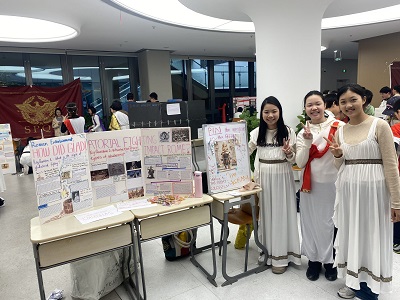
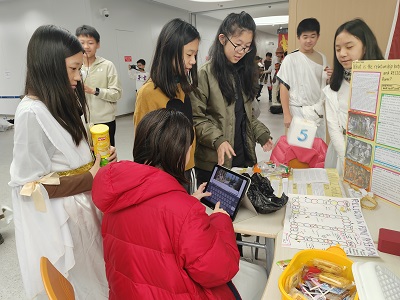
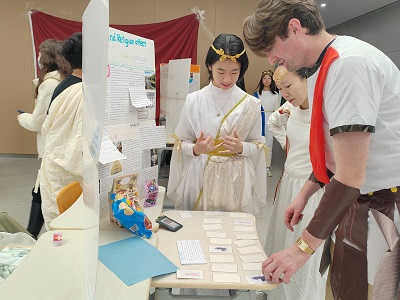
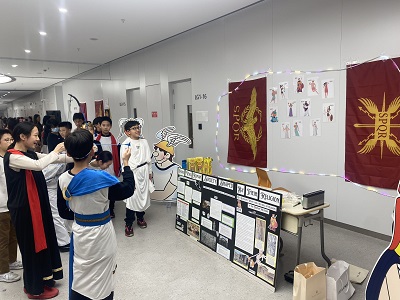
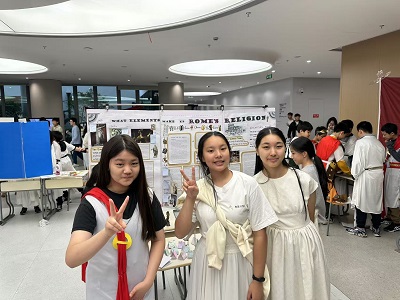
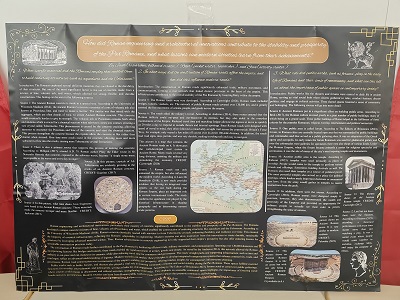
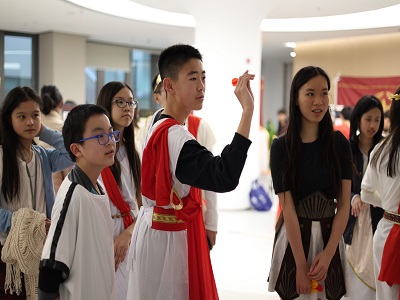
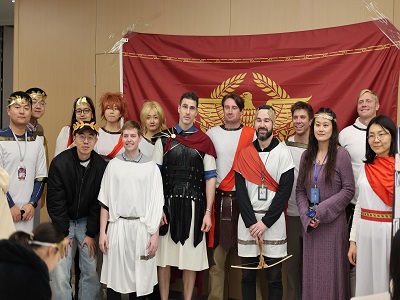
Written by Liu Chen
Pictures by Grade 7 teachers
Reviewed by Yunuo Li, Chenli Shen, Cong Luo, Sterling Endersby